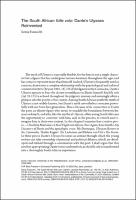Chapter The South African folle volo: Dante's Ulysses reinvented
| dc.contributor.author | Fanucchi, Sonia | |
| dc.date.accessioned | 2022-06-01T12:19:03Z | |
| dc.date.available | 2022-06-01T12:19:03Z | |
| dc.date.issued | 2021 | |
| dc.identifier | ONIX_20220601_9788855184588_504 | |
| dc.identifier.issn | 2704-5919 | |
| dc.identifier.uri | https://library.oapen.org/handle/20.500.12657/56319 | |
| dc.description.abstract | The figure of Ulysses haunts the pages of Dante’s Commedia, embodying a tension between past and present, and the potential and dangers inherent in any attempt at transformation. In this chapter I focus on four creative pieces by young South African students for whom Dante’s Ulysses becomes a rich and suggestive symbol. Despite their overt differences in approach, I argue that these pieces are all connected by a creative response to Dante, translating and conversing with his Ulysses from their personal and political perspectives. They are notable for their paradoxical approach to Dante’s hero, as they attempt to fashion new identities, to break free of the destructive influence of South Africa’s past, and to develop a more authentic, moral language. | |
| dc.language | English | |
| dc.relation.ispartofseries | Studi e saggi | |
| dc.subject.other | Dante’s Ulysses | |
| dc.subject.other | Ulysses in Africa | |
| dc.subject.other | folle volo | |
| dc.subject.other | nostalgia | |
| dc.subject.other | Ulysses myth | |
| dc.title | Chapter The South African folle volo: Dante's Ulysses reinvented | |
| dc.type | chapter | |
| oapen.identifier.doi | 10.36253/978-88-5518-458-8.10 | |
| oapen.relation.isPublishedBy | bf65d21a-78e5-4ba2-983a-dbfa90962870 | |
| oapen.relation.isbn | 9788855184588 | |
| oapen.series.number | 228 | |
| oapen.pages | 15 | |
| oapen.place.publication | Florence |

